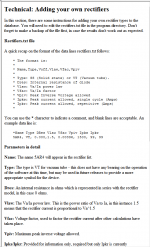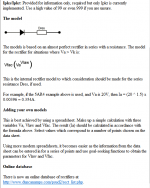Hi
I would really like to add a couple of rectifiers to use in this software, but I can't make head nor tail of some of the parameters that need to be used in the rectifiers.txt file to add your own. They are Va/Ia power law (Vlaw) and Va/Ia factor (Vfac). The help document simply talks about advanced excel spreadhseets allowing data from datasheet to be extrapolated to produce these, but provides no information on which data should be used etc.
It's a CGP15, CGP30, BY448 and BY228GP I am trying to model. From the specs I have access to the usual info ie If, Vrrm, Ifsm, Ir
Can anyone point me in the right direction here?
Thanks
Andrew
I would really like to add a couple of rectifiers to use in this software, but I can't make head nor tail of some of the parameters that need to be used in the rectifiers.txt file to add your own. They are Va/Ia power law (Vlaw) and Va/Ia factor (Vfac). The help document simply talks about advanced excel spreadhseets allowing data from datasheet to be extrapolated to produce these, but provides no information on which data should be used etc.
It's a CGP15, CGP30, BY448 and BY228GP I am trying to model. From the specs I have access to the usual info ie If, Vrrm, Ifsm, Ir
Can anyone point me in the right direction here?
Thanks
Andrew
Are your rectifiers really much different from, say, 1N4007?
If you are looking at VERY low voltage supply, forward drop may matter. High frequency invokes recovery times (but PSUD only does 50/60/400). Reverse Voltage, take the warning "your 1N4007 blew up!" and compare to the specs on your particular crystal.
If you are looking at VERY low voltage supply, forward drop may matter. High frequency invokes recovery times (but PSUD only does 50/60/400). Reverse Voltage, take the warning "your 1N4007 blew up!" and compare to the specs on your particular crystal.
If you have the latest PSUD2 version installed, and if you go to the website section where new or existing diodes can be graphically modelled:
PSUD rectifier parameters
then you can play around a bit - and as suggested it helps if you can identify a common diode type in the list that is somewhat close to your target diode - so you could start with a 1N4007 as being similar to CGP15.
As a practical check in a simulation, the results chart will show the MAX voltage and current for a diode in your simulation, and you can cross-check those forward conduction V and I values against the datasheet characteristic curve. Note that the datasheet willl show a curve based on a junction temperature, which can change significantly during operation, so be aware that PSUD2 will just provide an estimate based on what V-I curve you use for the model.
To modify your Rectifiers.txt file, you need to locate it (in my WIN10 OS it is in C:\Program Files (x86)\PSU Designer II) and you may need to change its file permissions to allow you to modify it.
When you play around with the modelling section, change Dres to zero to see the basic diode characteristic being applied, to which the voltage drop across the series resistor Dres is then added as current increases through the device (when Dres is made some value).
PSUD rectifier parameters
then you can play around a bit - and as suggested it helps if you can identify a common diode type in the list that is somewhat close to your target diode - so you could start with a 1N4007 as being similar to CGP15.
As a practical check in a simulation, the results chart will show the MAX voltage and current for a diode in your simulation, and you can cross-check those forward conduction V and I values against the datasheet characteristic curve. Note that the datasheet willl show a curve based on a junction temperature, which can change significantly during operation, so be aware that PSUD2 will just provide an estimate based on what V-I curve you use for the model.
To modify your Rectifiers.txt file, you need to locate it (in my WIN10 OS it is in C:\Program Files (x86)\PSU Designer II) and you may need to change its file permissions to allow you to modify it.
When you play around with the modelling section, change Dres to zero to see the basic diode characteristic being applied, to which the voltage drop across the series resistor Dres is then added as current increases through the device (when Dres is made some value).
Last edited:
Here are a couple examples of fitting SPICE model parameters (notice: SPICE is not PSUD2 and vice versa) to DC measurements of current and voltage in a diode.
They assume the reader is proficient at college mathematics, today, not "junior year" many moons ago, and also comfortable with log-log graphs.
If so then I imagine you can adapt these same procedures to PSUD2 directly. In both cases the model has a series resistance, and a superlinear (a/k/a power-law, a/k/a exponential) current vs voltage behavior.
They assume the reader is proficient at college mathematics, today, not "junior year" many moons ago, and also comfortable with log-log graphs.
If so then I imagine you can adapt these same procedures to PSUD2 directly. In both cases the model has a series resistance, and a superlinear (a/k/a power-law, a/k/a exponential) current vs voltage behavior.
Hi
Thanks for the info. I guess I'm trying to figure out how the terms power law and Vfac relate to those curves or to the Shockley equation that describes them. I will have a look at SPICE modelling and see how I get on.
Thanks
Andrew
Thanks for the info. I guess I'm trying to figure out how the terms power law and Vfac relate to those curves or to the Shockley equation that describes them. I will have a look at SPICE modelling and see how I get on.
Thanks
Andrew
Hi
I have modelled with the 1N4007, and I accept it may not make a great deal of difference, but I would just prefer to be able to "see" the model that reflects the diode I will actually be using.
Thanks
Andrew
I have modelled with the 1N4007, and I accept it may not make a great deal of difference, but I would just prefer to be able to "see" the model that reflects the diode I will actually be using.
Thanks
Andrew
- Status
- Not open for further replies.
- Home
- Amplifiers
- Power Supplies
- Duncan amps PSU designer - add rectifier

